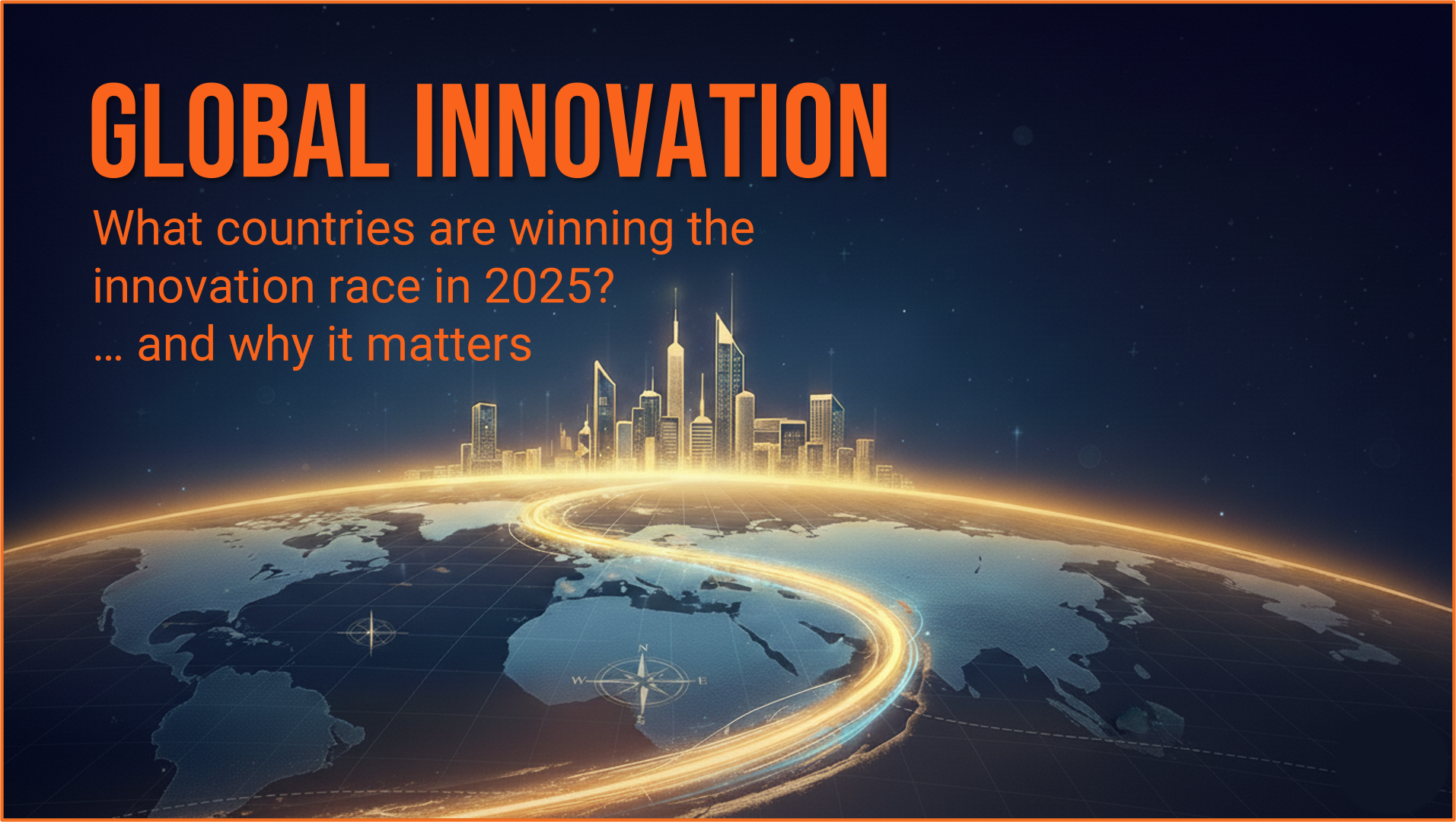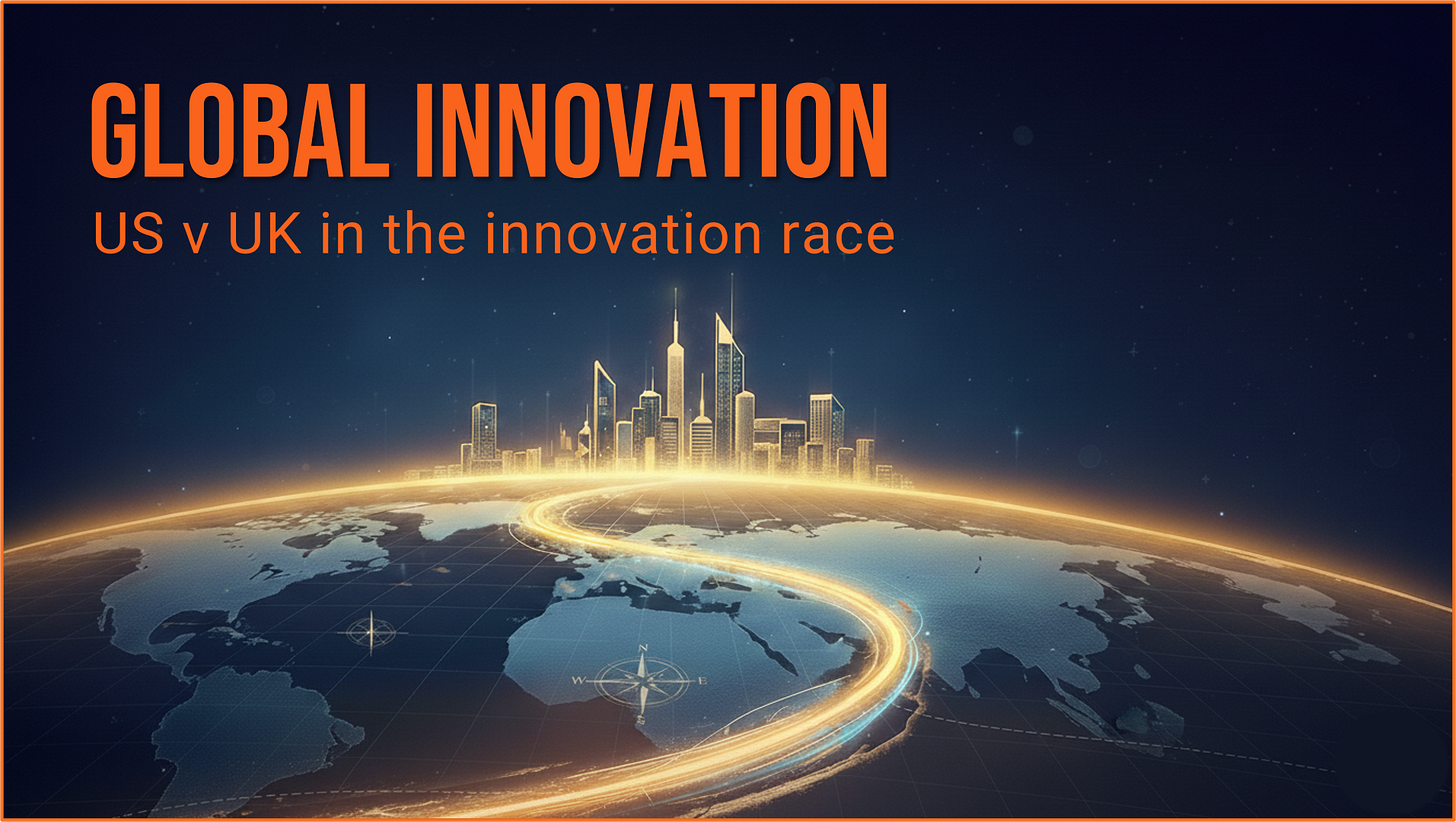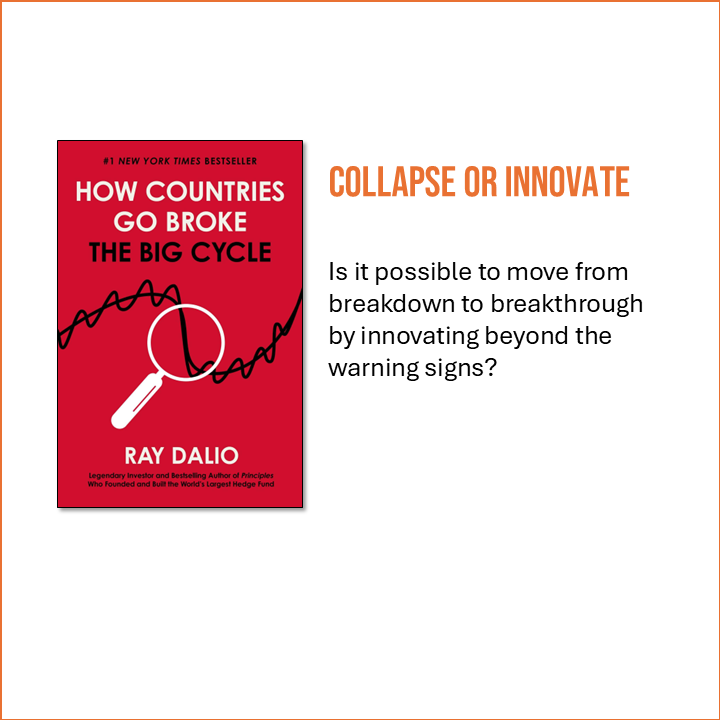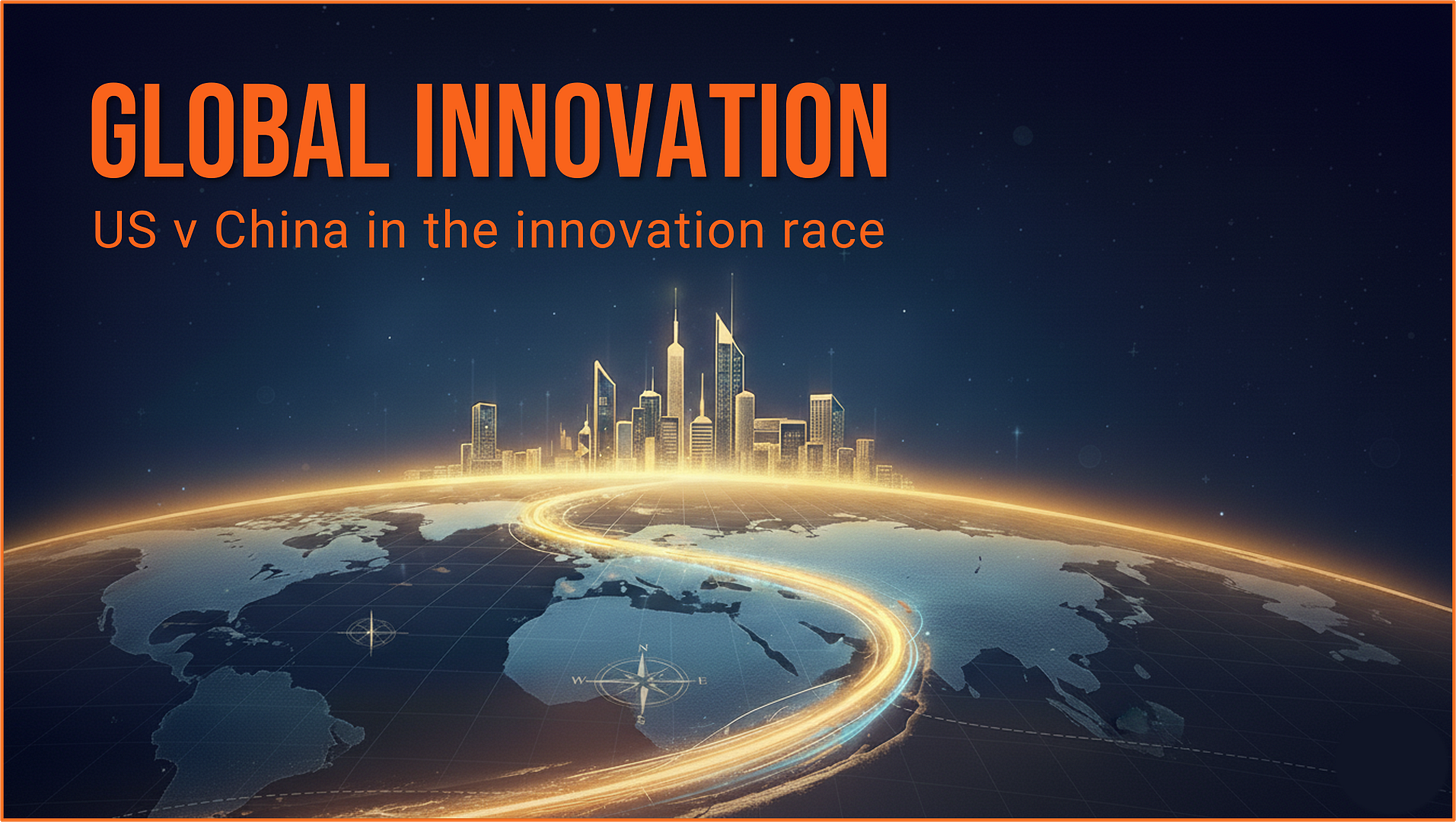What the Global Innovation Index GII Reveals About Our Future
“The fastest-advancing economies are those that view innovation as a fundamental engine of resilience, growth and competitiveness.” WIPO Director-General Daren Tang, GII 2025
The Global Innovation Index 2025 highlights emerging nations and widening cultural divides. Discover why sustainable innovation relies on navigating paradoxes and fostering inclusive ecosystems—and how national cultural shifts often mirror the dynamics within companies, teams, and leadership styles.
The hidden architecture of innovation
Years ago, a small island nation faced a dilemma. Its leaders wanted to connect two regions divided by a deep ravine.
One side of the ravine was known for wild creativity, the other for disciplined execution. Engineers proposed a sleek suspension bridge. The creative artists imagined a floating walkway of light. The rationalists and economists argued for a practical and profitable toll road. The debate stalled for years.
Then a young team consisting of a mix of designers, strategists, and community leaders proposed something radical: build two levels to the bridge. One that allowed for creative experimentation, and one that ensured reliable and efficient delivery. The idea was to let people choose their preferred path depending on the specific need at the time.
It worked, and innovation flourished. Not because they chose one model over the other, but because they embraced both and designed for the tension between the two perspectives.
This story, though fictional, reflects a deeper truth. As the WIPO Global Innovation Index 2025 shows, the most resilient innovation ecosystems are those that don’t eliminate paradox, but rather those that can build bridges across it.
Beyond rankings: What the Global Innovation Index 2025 misses about innovation
The Global Innovation Index (GII2025) offers more than rankings. It’s a mirror — reflecting both our progress and our blind spots.
Switzerland leads for the 15th year. Sweden and the US hold steady. Korea climbs to 4th. China breaks into the top 10 for the first time.
But beneath these headlines lies a deeper story: global R&D growth is slowing, corporate innovation is narrowing, and venture capital is retreating to familiar territory.
So why is this important and what can we learn from all this?
This isn’t just an economic shift. It’s a strategic inflection point.
It has been found that nations that cultivate innovation the best are not only fast-moving but also fair, inclusive, and future-ready. Democratic nations that embrace both perspectives typically produce the highest number of patents.
The same principles apply beyond national borders. Companies, like countries, are shaped by their underlying cultures. These cultures will either nurture innovation or quietly suppress it. These foundational dynamics determine whether an organization stays ahead or slips into irrelevance.
Our research highlights a crucial insight: sustainable innovation requires the capacity to embrace paradox. It’s not enough to choose between competing priorities. The most innovative companies and teams are those that can hold creative tension and navigate it with agility.
Whether we’re looking at national leaders shaping policy, CEOs driving transformation, or frontline teams executing strategy, the common thread is clear: high-performing innovators know how to balance critical cultural elements such as freedom with structure, autonomy with alignment, and speed with sustainability.
Through our work, we’ve mapped how leaders can actively navigate these paradoxes, not just conceptually but also practically. These paradoxes aren’t simply problems to solve, they’re active dynamics to learn to master.
Who’s really winning the ‘innovation race’ — and why culture is the real gamechanger
The GII 2025 confirms what many of us have sensed: innovation ecosystems are under strain. But it also highlights hope. Middle-income economies like India, Vietnam, Türkiye, and Morocco are rising — not because they mimic the West, but because they’re building contextually relevant, resilient cultural models.
Culture isn’t confined to the walls of an organization or the borders of a nation. It ripples through every group from small teams to entire countries, shaping mindsets, behaviors, and outcomes. And because these patterns are universal, there are core principles that can be learned and applied to foster innovation and build resilient innovation ecosystems.
What does all this mean for leaders?
It means it’s time to move beyond simplistic metrics. Innovation isn’t just about patents or R&D spend. It’s about the psychological, cultural, and strategic conditions we create, which allow ideas to emerge, spread, and scale. And it means we must design for continuity.
Innovation is not a sprint. It’s a relay that must last across generations, disciplines, and sectors.
As we digest the GII 2025, it may not be helpful just to ask “who’s winning?” but “what are we learning?” We will need to start to consider how can we build ecosystems that truly unlock human potential within our own teams and circle of influence.
Why Culture Provides the Real Competitive Edge in The Innovation Race: Comparing the US and UK (Part 2)
What if the real race isn’t just to innovate faster—but to innovate smarter?
In a recent Diary of a CEO episode, investor/author Ray Dalio lays bare the cultural fault lines driving global instability, revealing why some nations thrive while others stall. His insights echo a deeper truth we’ve seen firsthand: innovation isn’t a sprint toward the next big idea, it’s a strategic dance with complexity. And unless leaders learn to navigate the inherent paradoxical tensions, even the boldest ideas risk burning out before they break through.
Listening to Ray Dalio, I was struck by how clearly he outlines the forces shaping global instability and what leaders must do to respond. In particular, he outlines some interesting contrasts between the cultures of the US and the UK and how this impacts innovative development.
Dalio warns that both the US and UK are facing serious challenges: rising debt, widening inequality, and deepening political polarization. Yet he highlights a key cultural difference. The US has historically fostered entrepreneurial optimism, encouraging ideas to flourish and risk-taking, whereas the UK has leaned toward supporting established institutions and tradition — a mindset that can restrict innovation and slow progress.
The core culture components
This cultural lens is critical. In our work with leadership teams around the world, we’ve seen a recurring pattern: the race to innovate often bypasses addressing the deeper, competing demands that define sustainable success. These themes reflect the core message of our book The Innovation Race. Innovation isn’t just about chasing the next big idea, it’s about strategically navigating paradoxes to create a culture for sustainable change.
Many countries have a cultural DNA that can either foster or hinder innovation through a focus on either ‘exploration’ or ‘preservation’. However, innovation requires both perspectives. The entrepreneurial risk-taking spirit AND the more cautious, systematic approach. A paradox is not a dilemma to be seen as an either/or choice, but rather as the need to adopt both perspectives at the same time.
Within each orientation, Gaia has identified in her research four paradox pairs that present as nested innovation dimensions — culturally embedded paradoxical traits or values that influence how innovation can be supported by embracing both perspectives. These principles can be identified in nations and across organizations.
The paradox pairs that make up the nested innovation dimensions include:
- Freedom (exploration) & Control (preservation)
- Openness (exploration) & Focus (preservation)
- Collaboration (exploration) & Independence (preservation)
- Flexibility (exploration) & Stability (preservation)
These nested innovation dimensions outline the unique qualities that can shape innovation potential. They can be measured to assess the true sustainability of an individual, team or organization’s innovation leadership approach and strategy.
How do the US and UK compare?
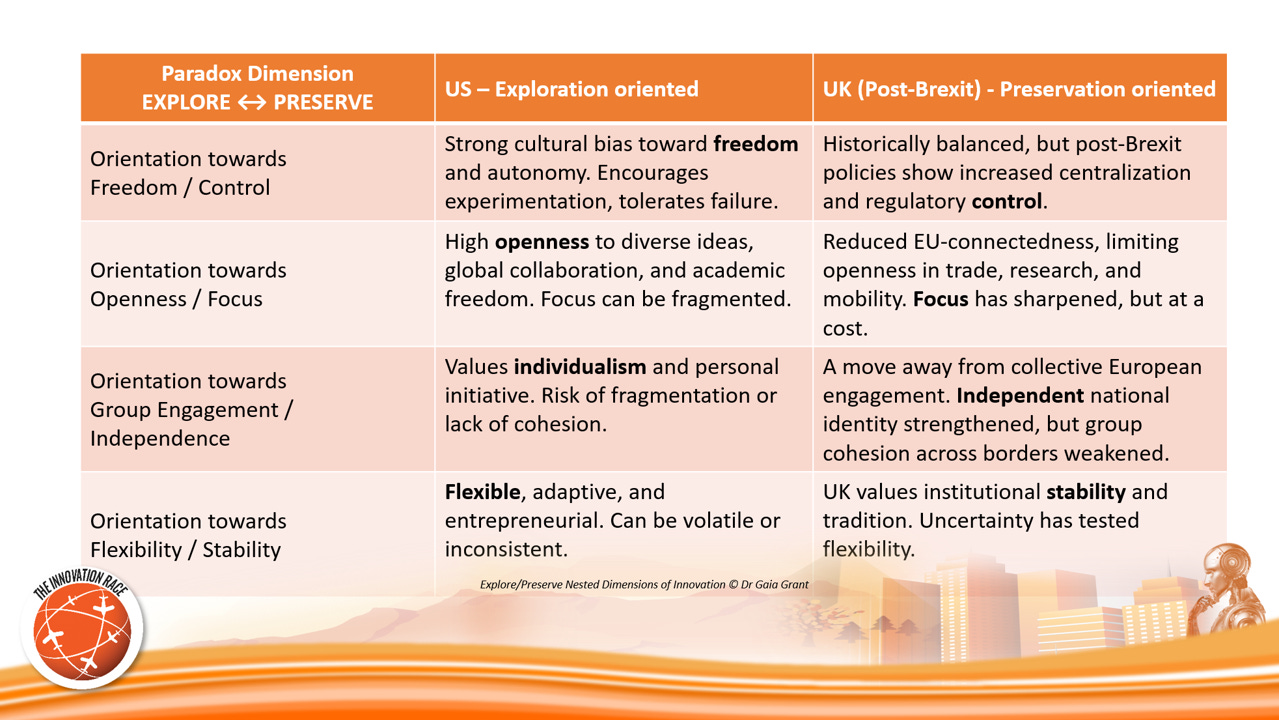
The US continues to lean into the Explore mindset, fostering disruptive innovation through openness, freedom, and individualism. The UK, which once benefited from a connection with Europe and a more collaborative approach (two of the associate ‘exploration’ nested dimensions), has shifted toward the Preserve orientation through Brexit, now favoring control, focus, independence and national security for more perceived stability. This repositioning may offer short-term clarity, but could also risk long-term isolation unless balanced with a return to more, freedom, openness, collaboration and flexibility.
Ray Dalio’s models of long-term cycles — including debt dynamics, internal conflict, and geopolitical competition — show how cultural foundations influence whether a country rises or declines. Innovation, in this context, becomes a cultural capability: the ability to adapt, align, and evolve through complexity.
It will only be through navigating the two orientations effectively that we will see sustainable success.
Innovation Ecosystems Under Pressure: Why China’s Strategic Shift Shouldn’t be Ignored (Part 3)
“For years, many in the West believed China had lost its innovation edge. After decades of explosive growth, Beijing’s internal crackdowns on tech and education, and its aggressive “wolf warrior” diplomacy, seemed to stall its momentum. Entrepreneurs were silenced. Neighbors distanced themselves. The narrative was comforting: China had stumbled, but not so anymore.” Fareed Zakaria, Journalist and Political Commentator, CNN
Times have changed. Where once China was viewed by the West as an innovation backwater, it’s just this year ranked among the top ten countries in the Global Innovation Index for the first time. Just over ten years ago, the country ranked outside the top 30.
China has quietly recalibrated its global posture—not by retreating, but by reasserting itself through innovation, infrastructure, and influence. From AI to green energy, its investments signal a long game. While Western headlines focused on internal crackdowns, China was laying the groundwork for technological dominance and soft power expansion.
Bloomberg’s tracking of 13 critical technologies shows China surging ahead. China now hosts the most top 100 global science and technology clusters, with Shenzhen-Hong Kong-Guangzhou ranked #1 globally.
When comparing China’s rapid trajectory to the way the US has been led within the past year, Fareed Zakaria has identified that, “While the one country doubled down on protectionism—threatening tariffs on foreign-made movies and lashing out at the UN—the other pivoted. China’s president proposed a sweeping global governance initiative, positioning itself as a constructive, agenda-setting superpower.”
And the shift isn’t just diplomatic. It’s deeply strategic. This is not just policy. It’s positioning. Take the Belt and Road Initiative, for example, which was once seen as a simple trade route revival but now also clearly serves as a digital and diplomatic corridor.
Innovation as Leverage
As we discussed in Part 2 of this series, a key driver of innovation is cultural mindset.
The U.S. has long thrived on optimism and a tolerance for failure—encouraging experimentation and resilience. This psychological safety fuels creativity. In contrast, cultures that penalize failure often suppress the risk-taking innovation demands.
Effective innovation needs guardrails, but not excessive control. A balance between exploration and preservation is essential. When that balance shifts, so does the capacity to innovate. Culture doesn’t follow innovation—it shapes it.
This strategic integration is central to The Innovation Race. Innovation isn’t just about breakthroughs, it’s about the cultural and systemic conditions that allow them to scale.
China’s shift from reactive to opportunistic, as noted by Julian Gewirtz and Jeffrey Prescott, reflects a deeper cultural model —one that values long-term planning, consistency, and strategic alignment with the competing demands of innovation.
The Paradox of Sustainable Innovation
Our research with over 70 global innovation leaders identifies four key paradoxical tensions that can be seen as nested innovation dimensions. These tensions are between the overarching competing demands of exploration and preservation: Freedom (exploration) & Control (preservation); Openness (exploration) & Focus (preservation); Collaboration (exploration) & Independence (preservation); Flexibility (exploration) & Stability (preservation).
Each pair must be balanced. Lean too far into the Exploration dimensions, and you risk chaos, drift, groupthink, and a lack of reality. Lean too far into the Preservation dimensions, and you risk oppression, insulation, disengagement, or rigidity. Mastering both sides is essential because at the extremes, innovation doesn’t soar; it implodes.
How do the US and China compare?
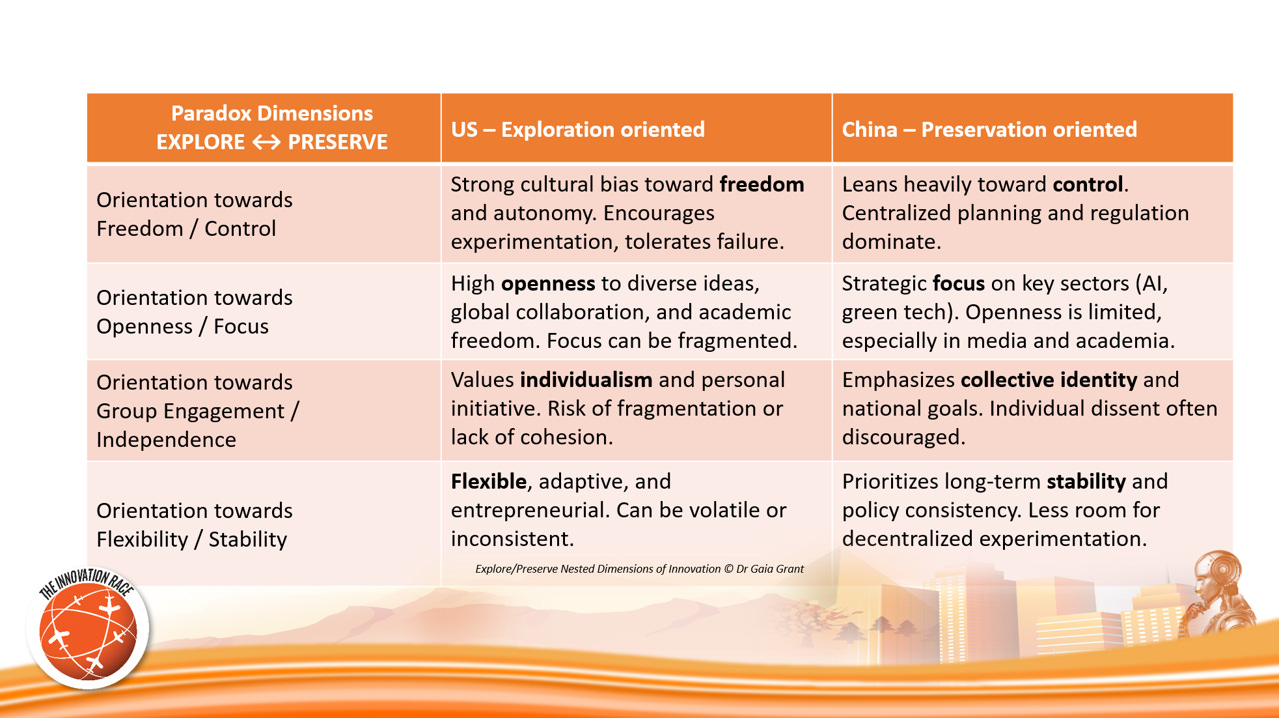
The US has been successful by embracing an Exploration mindset, championing freedom, openness, and individualism to spark disruptive innovation. China on the other hand, has leaned toward a Preservation orientation, prioritizing control, focus, and stability to drive strategic scaling.
It can be seen how contrasting the two approaches are when compared on the nested innovation dimensions, as shown in the table below.
Both models can succeed as long as there is some balance, and each risks collapse if pushed to extremes. Sustainable innovation depends on maintaining tension between these forces, not tipping too far in either direction.
From Tension to Turbulence: The Risk of Drifting into Danger
Innovation flourishes where these competing demands are effectively held in tension. However, when the cultural landscape exhibits signs of innovation slippage, it is often due to a drift toward the extremes. Moving too far in either direction—toward rigid control or unchecked chaos—can destabilize the very conditions that allow innovation to thrive.
Fragmentation, political gridlock, and declining trust in science threaten to weaken innovation ecosystems across the board. When openness is restricted—whether in academia, media, or global collaboration, diverse thinking narrows, and disruptive ideas struggle to surface.
It’s worth considering which nations are managing these tensions best, and which may be slipping. As we race toward the future, it may be a story of reversal: those countries that once led may start lagging behind.
These cultural fault lines reveal who’s gaining ground, who’s losing momentum, and who risks falling out of the innovation race entirely.
What Leaders Must Learn
These principles are universal. They apply to both countries and companies, shaping the cultural conditions that either ignite or inhibit innovation.
The real innovation race is cultural. It’s about navigating paradox: bold ambition with strategic caution, speed with sustainability, and freedom with alignment.
As Zakaria’s analysis shows, some countries are playing a long game. If the West wants to stay in the race, it must rethink not only its investments but also its mindset.
Read the full set on Substack:
- Part 1 Global Innovation– The Global Innovation Index, What It Really Tells Us About the Future of Work and Leadership
- Part 2 US vs UK — Who is Sprinting, Who is Stalling, and Why it Matters (when it comes to innovation culture)?
- Part 3 US v China – Innovation Ecosystems Under Pressure: Fault Lines That Predict the Future
- Further reading: China’s global technology and engineering ascendancy continues (ABC Alan Kohler)
More Resources
- Books: The Innovation Race – offers a provocative exploration of how organizations can shift from short-term competitive innovation to long-term, purpose-driven transformation. Drawing on global case studies and a paradox navigation framework, the book challenges the assumption that faster innovation always wins—arguing instead for cultures that balance creative freedom with strategic discipline. https://mybook.to/theinnovationrace
- Keynote or Workshop: The Agile Innovation Organisation (featuring “The Innovation Race” gamified simulation)
- Read this article on Substack and LinkedIn


